Newsletters
- Home
- Publications
- Newsletter Archive
- Newsletter
July/August 2019
Inside This Issue:
- Research Examines Statutes, Regulations to Control Invasive Species
- Chairman's Message
- Pennsylvania Adds 47 Farms to Preserved Farm Status
- Rural Snapshot: Gender Pay Gap
- It's Electric: Vehicles and Charging Stations
- Just the Facts: Take Cover! It's a Tornado
- Farm to School Census Set for September
Control, prevention, eradication
Research Examines Statutes, Regulations to Control Invasive Species
Invasive species, like the spotted lanternfly and brown marmorated stinkbug, can wreak havoc on Pennsylvania’s environment and its economy. Unfortunately, government efforts to control invasive species, both nationwide and in Pennsylvania, can be described as slow and reactive, according to recent research by Dr. Sara Grove and Dr. Michael Moltz of Shippensburg University of Pennsylvania.
In their research to better understand government approaches to dealing with threats from invasive species, the researchers found that, nationwide, about 50 percent of the efforts to address invasive species were related to control, often of specific insects, plants, or aquatic life. Nine percent of the statutes and regulations were focused on prevention, and only 4 percent emphasized eradication. Roughly 18 percent of the efforts had mixed goals (typically, control and prevention) and another 18 percent were classified as other. This last category included the development of administrative structures, including state invasive species councils.
The research was sponsored by the Center for Rural Pennsylvania.
Research background
The researchers first examined public documents from the National Invasive Species Council’s existing Management Plans. The team then identified and reviewed public documents from Pennsylvania’s Invasive Species Council and existing state Management Plans. Much of the research examined other states’ statutory and regulatory efforts to control invasive species, including sources of funding.
The researchers contacted states with invasive species programs that related to threats in Pennsylvania, and asked for information on funding sources devoted to controlling invasive species and any research reports on the effectiveness of the programs.
Finally, the research team completed four case studies related to invasive species identification, suppression, and eradication.
Research findings
Overall, the research found that Pennsylvania’s efforts to control invasive species are reactive, with the Pennsylvania Invasive Species Council being created only in 2004, and with the first comprehensive species management plan implemented before the end of the Rendell administration. The council entered a dormant period during the Corbett administration and was only reinvigorated by Governor Wolf in 2017. Furthermore, Pennsylvania has no dedicated funding streams for addressing outbreaks of invasive species. Rather, when threats arise from invasive species, departments use general fund monies or rely on grants from the federal government until the next budget cycle.
The analysis of the statutory and regulatory efforts to control invasive species nationwide indicated that there is no uniform approach to addressing invasive species. Congress has paid sporadic attention to these issues, leaving most efforts to regulatory agencies (typically, the U.S. Department of Agriculture and the U.S. Department of the Interior). Once invasive species are detected, state efforts focus on control, less effort is dedicated to prevention, and little is directed toward eradication.
The four policy case studies showed the benefits of interagency cooperation and interstate coordination. They indicated that management expertise and funding are critical because invasive species do not respect agency or state boundaries. To be effective, efforts to control and prevent the spread of invasive species require a holistic approach.
When reviewing reports from federal and state agencies involved in controlling the spread of invasive species, the researchers noted a common theme €“ namely, inadequate funding. The research found that the federal government provides funding primarily through programs under the U.S. Department of Agriculture, typically those associated with the Farm Bill and directly linked to invasive species that threaten agriculture. Funding to address invasive aquatic species comes from the U.S. Fish and Wildlife Service. Furthermore, federal agency efforts rely on cooperation with their state counterparts.
The research found that states use a variety of funding mechanisms to support efforts to detect, suppress, and eradicate invasive species.
Policy considerations
Based on the evaluation of existing state statutes and regulations, as well as the four case studies, the researchers identified several policy considerations: one of which is to provide institutional support and dedicated funding for the Governor’s Invasive Species Council, including a statewide invasive species coordinator.
Full report available
Click here for a copy of the full report, Legislative and Regulatory Efforts to Control Invasive Species.
Chairman's Message
Across the nation, invasive species have been taking their toll on wildlife, waterways, agricultural productivity, tourism, outdoor recreation and more. These invaders also have been costing billions of dollars in damages over the years. A report by the U.S. Fish and Wildlife Service noted that the U.S. spends more than $120 billion on invasive species each year.
From the gypsy moth to the zebra mussel, Pennsylvania is no stranger to the damage invasive species can cause and the impact they can have on our environment, our economy and even our health. The latest threat to Pennsylvania is the spotted lanternfly. Currently, there is a quarantine zone that covers 14 counties in Pennsylvania, including Berks, Bucks, Carbon, Chester, Dauphin, Delaware, Lancaster, Lebanon, Lehigh, Monroe, Montgomery, Northampton, Philadelphia, and Schuylkill counties. The Pennsylvania Department of Agriculture and Penn State University and Extension have come together to control and contain the spread of spotted lanternfly (SLF). The department is regulating the movement of commodities that may be moving within or leaving the quarantine zone, and it is restricting the movement of articles that contain any life stages of SLF, including egg masses, nymphs, and adults. Businesses operating in the quarantine zone must have permits to move equipment and goods within and out of the zone. To learn if your business or organization is required to carry permits, visit Penn State Extension by clicking here. Following the quarantine requirements will help to contain the spread of this pest.
The Center’s board was well aware of this latest threat to Pennsylvania, and in 2018, it supported research to document what Pennsylvania and other states are doing to control and prevent invasive species. The research, conducted by Shippensburg University’s Dr. Sara Grove and Dr. Michael Moltz, found that there are no uniform approaches to controlling, preventing or eradicating invasive species nationwide. However, the research case studies indicated that there are benefits to interagency cooperation and interstate coordination, and noted the importance of the Governor’s Invasive Species Council. The council is chaired by the Secretary of Agriculture and includes members from state agencies and the public who represent agriculture and natural resource organizations and educational institutions conducting invasive species research and outreach. The results of that research are featured on Page 1.
In the coming months, we will share the results of research on the economic impact of SLF on Pennsylvania agriculture and forests. We trust that the information from these two projects will help Pennsylvania move forward in its efforts to prevent and control invasive species.
Senator Gene Yaw
Pennsylvania Adds 47 Farms to Preserved Farm Status
Pennsylvania’s Agricultural Land Preservation Board in June preserved an additional 47 farms covering 3,561 acres in 21 counties across the state. The farms are in Berks, Bucks, Chester, Columbia, Cumberland, Dauphin, Juniata, Lackawanna, Lancaster, Lawrence, Lebanon, Lehigh, Lycoming, Mercer, Monroe, Montgomery, Northampton, Schuylkill, Tioga, Union, and Westmoreland counties.
Since the Pennsylvania Agricultural Conservation Easement Purchase Program began in 1988, federal, state, county, and local governments have purchased permanent easements on 5,540 farms, totaling 569,767 acres, in 59 counties for agricultural production.
The ag purchase program is dedicated to slowing the loss of prime farmland to non-agricultural uses. Funding allows state, county and local governments to purchase conservation easements from owners of quality farmland. State, county, local, and federal funds are allocated to county programs to purchase the development rights to preserve farms on county waiting lists.
For more information about the Pennsylvania Agricultural Conservation Easement Purchase Program, click here.
Rural Snapshot: Gender Pay Gap
This Snapshot looks at the female/male pay gap. The data do not take into account years of service or job title. Full-time, year-round workers are employed 35+ hours per week and 50+ weeks per year.
Average Monthly Wages for Rural and Urban Pennsylvania Workers, by Gender, 1st Quarters 1998, 2008, and 2018
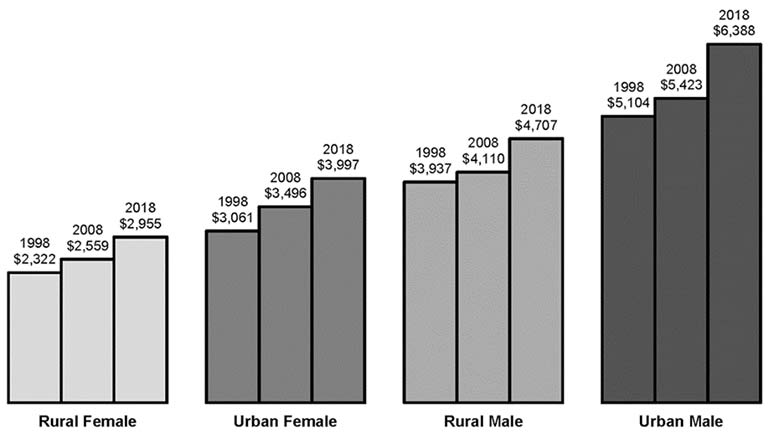
Data exclude the self-employed. Data adjusted for inflation using the CPI-U with 2018 = 100. Data source: Longitudinal Employer-Household Dynamics, U.S. Census Bureau.
Median Income for Rural Pennsylvania Workers Who are Employed Full-time and Year-Round, by Gender and Other Characteristics, 2017
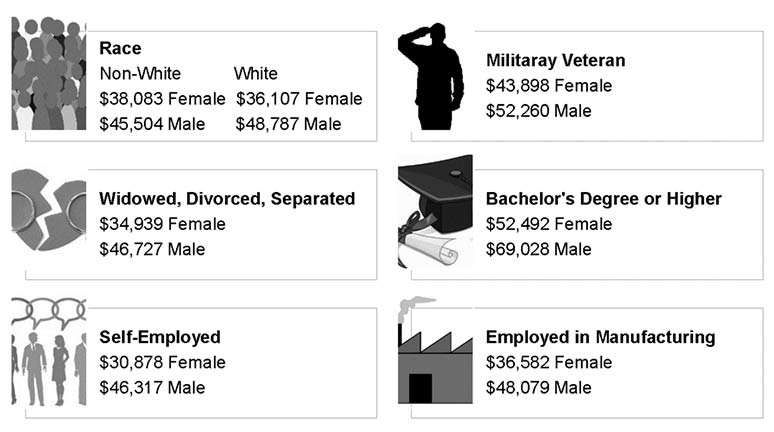
Income includes wages and salaries. Workers are employed full-time, year-round. Data source: 2017, 5-year average, American Community Survey, Public Use Microdata Sample, U.S. Census Bureau.
Household Wage/Salary Contributions by Gender in Married and Cohabitating Rural and Urban Pennsylvania Households, 2017
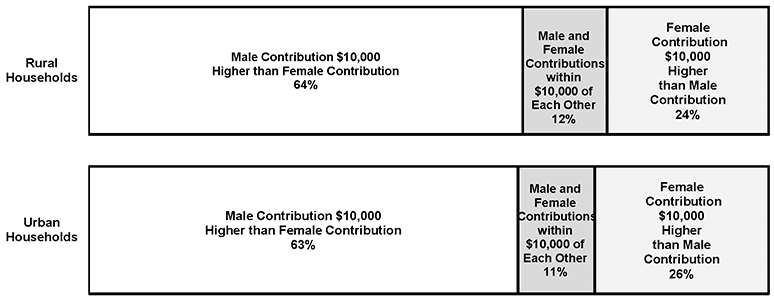
Data exclude same-sex households. Workers are employed full-time, year-round. Data source: 2017, 5-year average, American Community Survey, Public Use Microdata Sample, U.S. Census Bureau.
Average Monthly Wages in Private Sector Rural Establishments by Number of Employees, and by Gender, 2nd Quarter 2017
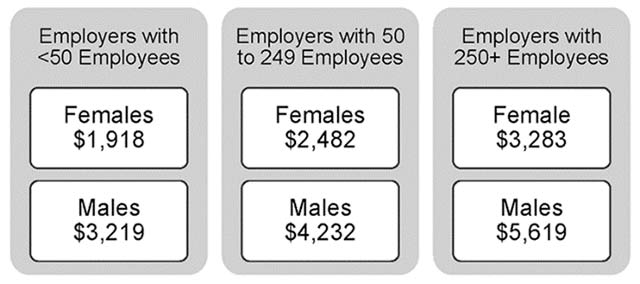
Data exclude the self-employed. Data source: Longitudinal Employer-Household Dynamics, U.S. Census Bureau.
Median Income for Rural Pennsylvania Female and Male Workers Employed Full-time, Year-Round, by Age, 2017
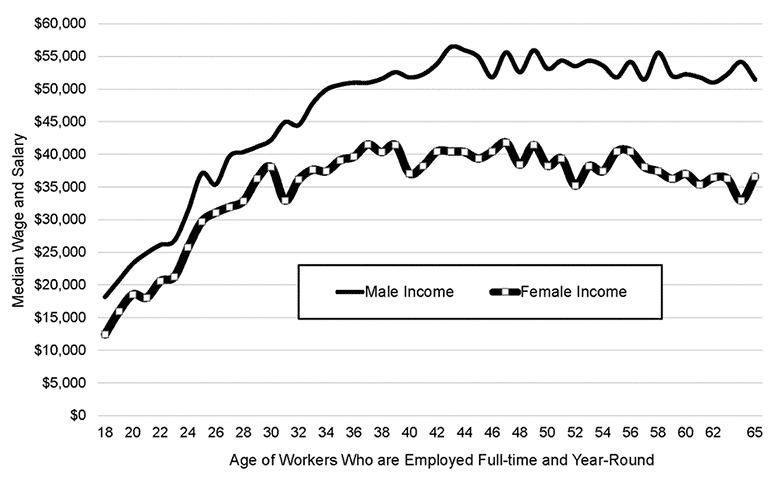
Income includes wages and salaries. Workers are employed full-time, year-round. Data source: 2017, 5-year average, American Community Survey, Public Use Microdata Sample, U.S. Census Bureau.
Percentage of Female Pay to Male Pay, by County, 2017
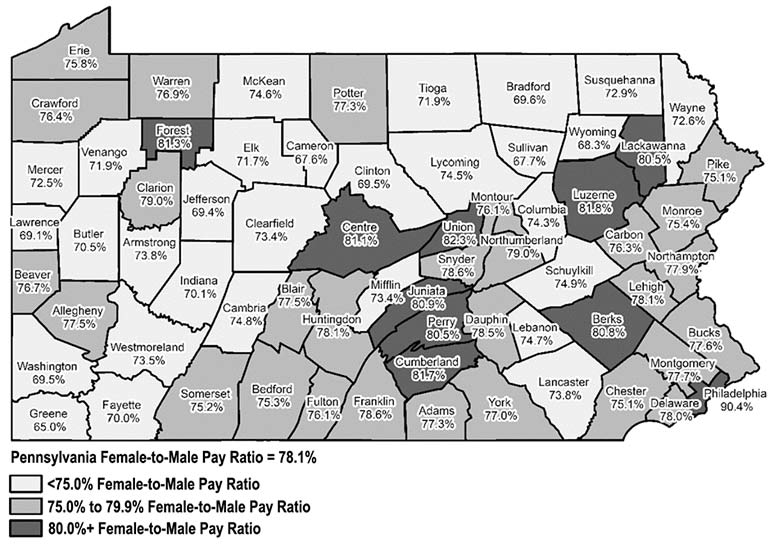
Data source: 2017, 5-year average, American Community Survey, U.S. Census Bureau.
It's Electric: Vehicles and Charging Stations
Wondering how many places there are throughout Pennsylvania to charge your new electric vehicle (EV)? According to the U.S. Department of Energy, as of May 2019, there are 449 electric vehicle charging stations in Pennsylvania that are publicly available. Eighty-four of these stations (19 percent) are located in rural counties and 365 (81 percent) are located in urban counties. Statewide, the majority of these stations (82 percent) are located about 5 miles from an interstate highway.
Nationwide, there are 21,975 charging stations. The three states with the most charging stations are California (5,224), New York (1,368), and Florida (1,205). The three states with the least number of charging stations are South Dakota, North Dakota, and Alaska, each with fewer than 50 stations. The Keystone State has the nation’s 15th highest number of stations with 449.
How many electric vehicles are on the highway? According to 2018 registration data from the Pennsylvania Department of Transportation, there are 6,900 registered electric vehicles in the commonwealth. In rural counties, there are 921 electric vehicles, or 0.03 percent of all rural vehicles. In urban counties, there are 5,979 electric vehicles, or 0.09 percent of all urban vehicles.
The number of electric vehicles in both rural and urban counties is on the rise. Over the last 6 years (2013 to 2018), the number of electric vehicles increased by about 200 percent in rural counties and by nearly 500 percent in urban counties.
According to the most current estimates from the U.S. Department of Energy, in 2017, there were 366,940 electric vehicles on the road. Nearly one-half of these vehicles (49 percent) were registered in California.
EVs captured less than 1 percent of new vehicle sales in 2017, according to the Alliance of Automobile Manufacturers, and only increased their share of the road by less than 1 percent from 2013 to 2017. While EVs do not appear to be gaining much traction presently, advancements in technology and/or new policies may change that outlook in the future. As clean energy options continue to be explored, it may be less a question of if EVs will dominate the market, and more a matter of when.
Number of Registered Electric Vehicles in Pennsylvania, by County, 2018
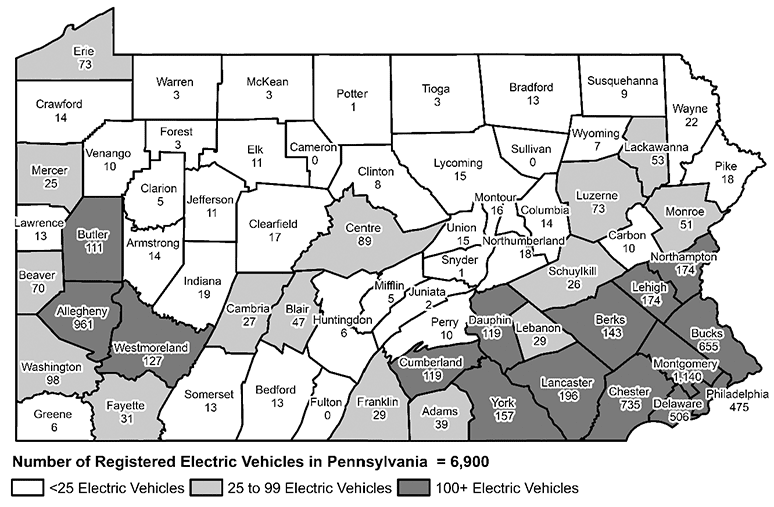
Data source: Pennsylvania Department of Transportation.
Just the Facts: Take Cover! It's a Tornado
From 1970 to 2018, 712 tornadoes have touched down in Pennsylvania, according to the National Oceanic and Atmospheric Administration. Pennsylvania ranks 24th among all states for the number of tornadoes. The states recording the highest number of tornadoes are Texas, Kansas, Oklahoma, Florida and Nebraska.
Over the past 49 years, Pennsylvania has witnessed close to 15 tornadoes per year. In 2018, there were 33 recorded tornadoes in Pennsylvania. The highest number of recorded tornadoes occurred in 1998 (62). Of the total 712 tornadoes, 63 percent (450) touched down in rural areas and 37 percent (262) were in urban areas.
When are these twisters striking? Forty-four percent of tornadoes occurred in the early summer months of June and July, and more than 63 percent of them touched down between 12 p.m. and 6 p.m.
Tornadoes are classified by their wind speed and can reach speeds of up to 318 miles per hour. In Pennsylvania, most tornadoes are rated either F1 or F2, which means they can reach speeds of up to 157 miles per hour. Even at these speeds, tornadoes can leave devastation and destruction in their wake.
Since 1970, tornadoes have caused 78 fatalities; 57 of them were in rural counties. In 1985, 65 lives were lost because of tornadoes. There have been 1,078 people injured by tornadoes since 1970, and 62 percent of the people injured lived in rural counties.
From 1970 to 2018, tornadoes have caused slightly more property damage in rural areas of the state than urban areas. However, the median amount of damage in rural areas is lower, at $25,000, than in urban areas, where the median damage amount is $50,000.
Farm to School Census Set for September
The Food and Nutrition Service's Office of Community Food Systems has announced the launch of the third Farm to School Census in September.
The Farm to School Census (the Census) is the only national survey that examines school districts’ farm to school activities, such as local food purchasing behaviors, the number and use of school gardens, and the frequency of agricultural education. The Census surveys all School Food Authorities participating in the USDA National School Lunch Program in all 50 states and U.S. territories.
The USDA Food and Nutrition Service has contracted with the research firm Abt Associates to administer the 2019 Farm to School Census. Abt will start contacting state agencies and school districts later this summer.
The Census is a valuable measure of the effectiveness, scope, and reach of farm to school activities, nationwide, over time. It’s important to participate in the Census, regardless of your school's current level of farm to school participation. Click here for more information.
